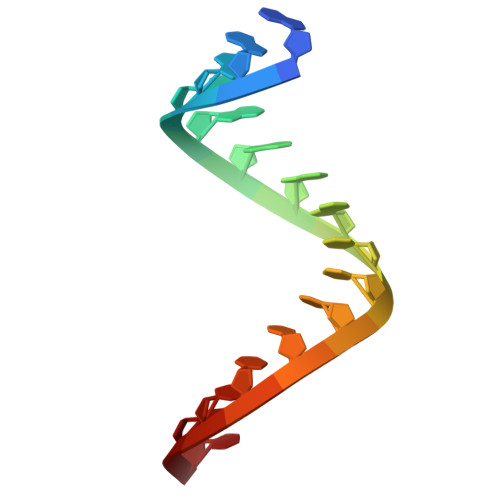Impact of 2'-deoxyribo-purine substrates on nonenzymatic RNA template-directed primer extension.
Fang, Z., Acikgoz, O., Jia, X., Essex, J., Wen, R., Szostak, J.W.(2025) bioRxiv
- PubMed: 40909494
- DOI: https://doi.org/10.1101/2025.08.29.673048
- Primary Citation of Related Structures:
9OKS, 9OKT, 9OKU, 9OKV, 9OKW, 9OKX, 9OKY, 9OKZ, 9OL0, 9OL1, 9OL2, 9OL3 - PubMed Abstract:
The composition of the primordial genetic material remains uncertain. Studies of duplex structure and stability, and of nonenzymatic template copying chemistry, provide insight into the viability of potentially primordial genetic polymers. Recent work suggests that 2'-deoxyribo-purine nucleotides may have been generated together with ribonucleotides on the early Earth. Since DNA/RNA duplexes are known to be less stable than RNA/RNA duplexes, we have examined the impact of dA, dI, and dG substitutions on RNA structure and nonenzymatic template copying. We find that single 2'-deoxyribo-purine substitutions reduce RNA duplex stability, as expected. Crystallographic studies show that such substitutions lead to minimal structural changes but point to diminished solvation as a likely reason for duplex destabilization. Kinetic studies show that dI and dG substrates exhibit slightly weaker template binding and slower rates of template-directed primer extension than the corresponding ribo-purine substrates. In contrast, dA substrates exhibit much slower reaction kinetics but higher template affinity than rA substrates. Our results suggest that a mixed RNA/DNA primordial genetic polymer would have suffered from moderately slower rates of template copying, but that this could have been offset by an advantage due to more facile strand separation or exchange.
- Howard Hughes Medical Institute, Department of Chemistry, The University of Chicago, Chicago, IL 60637, USA.
Organizational Affiliation:

















